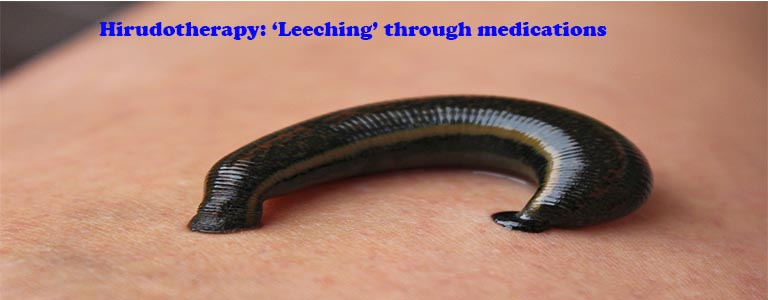Hirudotherapy: ‘Leeching’ through medications
Leeches have been successfully used to treat a wide variety of diseases since the ancient times. Till date, the blood sucking insects have been used to treat nervous system abnormalities, skin diseases, dental problems, and infections. Being inexpensive and relatively simple, leech therapy has also been used in cosmetic surgeries and other microsurgeries.
How do leeches help?
Leeches used in medicine, often imported from Sweden or Hungary, have three jaws, all embedded with tiny teeth. When they bite the skin of the individual undergoing treatment, they release anticoagulants through their saliva. The secreted anticoagulants, naturally thins the viscosity of blood of patient and inhibits coagulation of their platelets. After they have bitten, they are allowed to suck blood of patient for 20-45 minutes depending upon the kind of treatment the patient is undergoing.
Medical applications of leech therapy:
As mentioned above, this therapy has a multitude of applications in the field of medicine. The chemicals released with the leech saliva have also been used to make a number of medicines and therapeutics to treat many diseases.
- Cardiovascular diseases: Because of the anticoagulant property to naturally thin the blood of the patient, leech therapy is very popular is treating heart related disorders.
- Cancer: This area is still being explored by scientists. However, leeches have been shown to be effective against lung cancer.
- Diabetes: Leech therapy has been found to be very effective towards treating diabetes, especially by lowering the blood pressure of heart of diabetic patients.
- Migraines: This form of therapy enhances the blood flow in the areas where treatment is being carried out because of blood suction by the leeches. Hence, conditions occurring due to low blood flow,as in migraines can be easily treated by this therapy.
- Cosmetics: Leech therapy has been found to be very effective in skin reconstructions of facial areas. Being completely natural, leeches are able to remove blood clots effectively after skin grafts or facial reconstruction.
Side effects of leech therapy:
Despite being natural, this therapy may sometimes cause complications in a few cases.
- Itching: If sheer force is applied on the leech for removal, its teeth may sometime still remain in the wound causing serious infection and itching.
- Bleeding: Prolonged hemorrhage may occur in some cases leading to anemia or even death of the patient.
- Sometimes, leeches have a tendency to migrate to areas other than the ones being treated, causing unnecessary complications during the treatment.
- Allergy: Some patients may experience itching and red rash over the areas that have been exposed during leech therapy.
If the patient does not exhibit any side effect during the testing stage of leech therapy, then this therapy can be employed to yield 100% effective results while treating most of the disease conditions. Also, despite leech therapies being an age old methodology, recent scientific studies on this subject are proof that ancient medicines can still be relied upon.
References:
- Sig AK, Guney M, Uskudar Guclu A, Ozmen E. Medicinal leech therapy-an overall perspective. Integr Med Res. 2017;6(4):337–343. doi:10.1016/j.imr.2017.08.001
- Jha K, Garg A, Narang R, Das S. Hirudotherapy in Medicine and Dentistry. J Clin Diagn Res. 2015;9(12):ZE05–ZE7. doi:10.7860/JCDR/2015/16670.6918
- Leechestherapy.com. (2020). [online] Available at: https://www.leechestherapy.com/about-leeches/benefits [Accessed 3 Feb. 2020].
- Healthline. (2020). What is Leech Therapy?.
[online]
Available at: https://www.healthline.com/health/what-is-leech-therapy#takeaway [Accessed 3 Feb. 2020].

